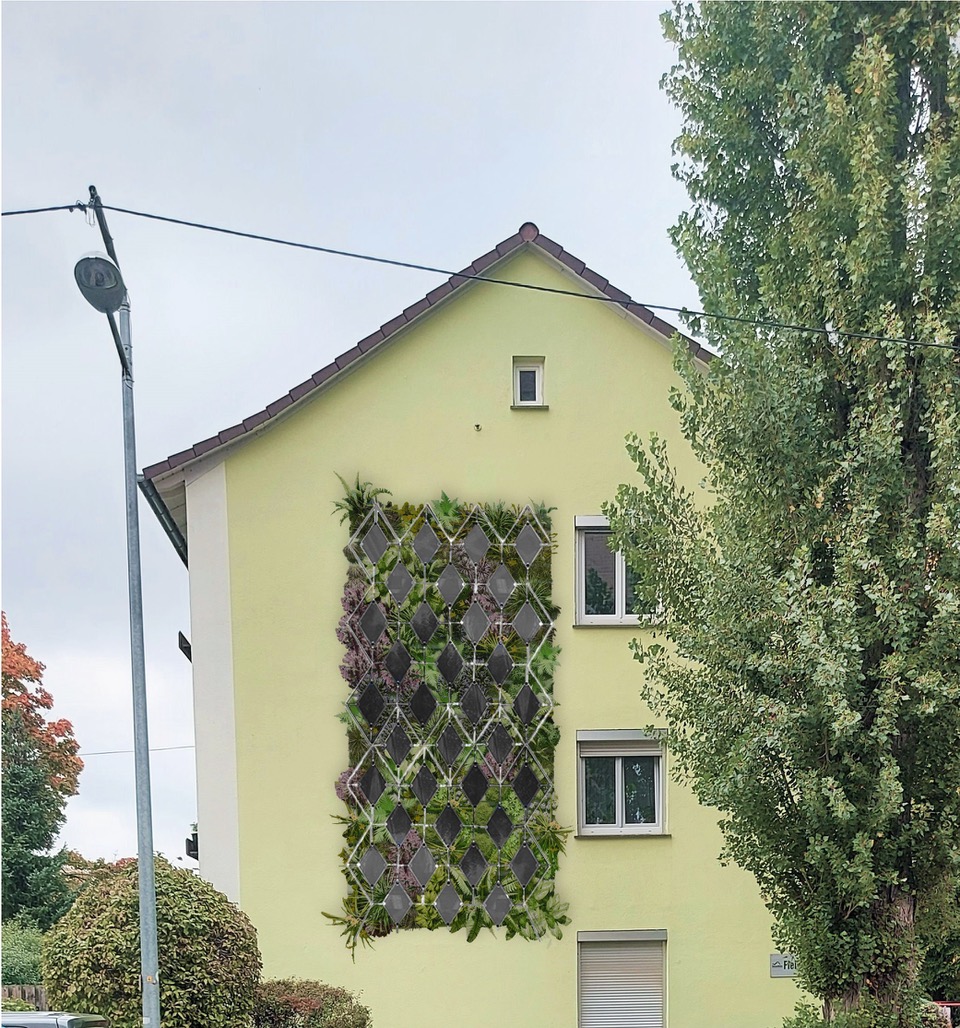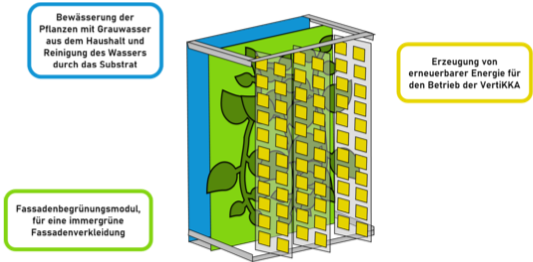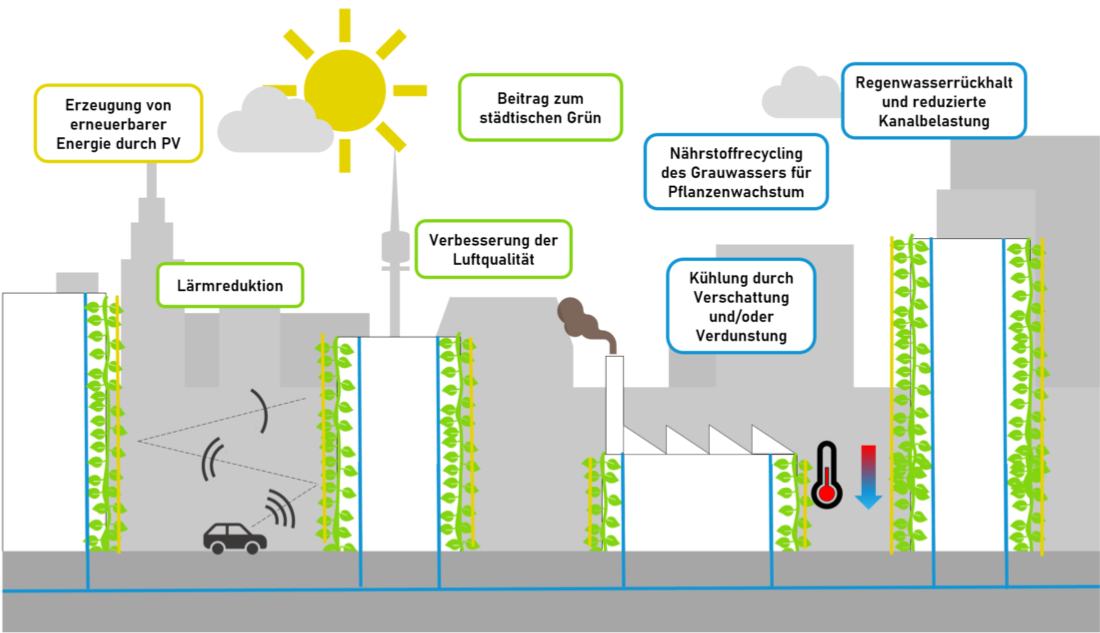Main navigation
FamoS: climate protection on facades
Resource-efficient water management, photovoltaic modules and innovative facade greening - FamoS is all that. By combining proven elements, the ‘facade module with synergy’ makes a valuable contribution to combatting climate change and boosting climate resilience in cities.

Urban agglomerations are facing increasing challenges due to climate change and the growing rural exodus. Cities are the centre of life and the workplace for more than three quarters of the population in Germany.1) Forecasts predict a further increase in the degree of urbanisation.2) According to the German Weather Service (DWD), these densely populated urban areas in particular are increasingly confronted with stress factors such as the heat island effect and extreme weather events such as droughts or heavy rain and associated flooding due to sealed surfaces, reduced green spaces and low air exchange.3)
Heatwaves are an environmental problem, but first and foremost they are a social challenge. In addition to property damage, increased mortality rates are probable, especially among the old, the vulnerable and the very young. In addition, increasing drought in recent years is leading more frequently to low groundwater levels and thus to conflicts in the drinking water supply.4) So how can urban housing be designed attractively for the future to take into account not only the needs of the population but also the necessary climate adaptation?
The facade module with synergy (FamoS) has been developed to overcome these challenges, initially in the building sector, which accounted for 16 percent of total CO2 emissions in Germany in 2020. A research project called VertiKKA was created to address heat provision, which significantly impacts energy consumption in the building sector, and the cooling of buildings, an increasingly important issue. Through the German Federal Ministry of Education and Research’s (BMBF), ‘Resource Efficient Urban Neighbourhoods’ funding line, nine partners from different science, business and public institutions formed a project consortium.5,6) The aim of their research was to develop a facade greening module that purifies greywater and produces electricity. This is how FamoS came into being.
How the facade module works
The facade module with synergy combines three components: photovoltaics (PV), facade greening and an irrigation concept. Driven by the electricity generated by the upstream semi-transparent PV modules, slightly polluted but nutrient-rich greywater from households (wastewater from washing machines, showers and wash basins) is fed into the facade greening module. The plants clean the greywater, which can then be re-used for watering the garden or flushing the toilet. Among other things, biochar is used as a purification substrate. "Pyrolysed grain husks have proven to be particularly suitable due to their cleaning function and their potential for storing carbon, nutrients and water," says Dr. Susanne Veser, chairperson of the Fachverband Pflanzenkohle e.V. and developer at SynerCity GmbH, which was founded as a result of the project.
"Unlike standard processes, in which greywater is pre-treated centrally on the ground by plants in a preliminary stage before being fed into the classic facade greening system, our system uses the constructed wetland directly as a facade greening system," says Kilian Lingen, expert in facade greening from CityArc, Institut für Stadtnatur AG.
The non-standard use of greywater for irrigation places high demands on plants, and therefore the conventional spectrum of plants cannot be used for greening. The choice fell on robust plants such as species of Bergenia and Geranium, daylilies (Hemerocalis), sedges (Carex), purple bellflowers (Heuchera) and water forget-me-nots (Myosotis scorpioides). These plants must be able to withstand a large amplitude of site factors such as nutrient and salt content, as well as wide temperature fluctuations and extremes.
Synergy effects as a unique selling point
The three components of FamoS benefit each other. While the semi-transparent photovoltaic modules protect the plants from extreme solar radiation and weather, the evaporative cooling effect of the plants increases the efficiency of the modules. The green electricity generated in this way either serves as a source of energy for the system's own needs or can be fed into the public grid. The facade greening system further purifies the pre-purified greywater and thus saves valuable drinking water resources, recycles nutrients while taking the pressure off sewage treatment plants. The system can act as a buffer during heavy rainfall events by temporarily storing rainwater and later releasing it at a reduced rate.
The vegetation not only cools interior spaces and protects facade components from extreme weather conditions, it also provides improved thermal insulation and thus minimises the building's energy loss. The plants also influence their immediate surroundings by providing an improvement in air quality, reducing fine dust pollution, reflecting sound, reducing noise and having an impact on the urban microclimate through shading and evaporation, as well as having a cooling effect on urban heat islands. Green facades improve the quality of life by aesthetically enhancing urban spaces, promoting biodiversity and contributing to the sustainable climate adaptation of cities by increasing energy, land and resource efficiency.
Climate protection at your fingertips
From 14 April to 8 October 2023, the functional principle of FamoS will be shown to larger audiences for the first time at the Federal Horticultural Show in Mannheim. In the contributions to the bioeconomy display, visitors will be able to touch the glass of the PV modules on a demonstration module, and observe how a wall-bound facade is constructed and how this has been combined with a greywater purification module. They can learn more about the numerous synergy effects of the system and gain an understanding of how they contribute to the bioeconomy.
Background
The three-year project ‘VertiKKA - Vertical Climate Purification Plant for Increasing Resource Efficiency and Quality of Life in Urban Areas’ was funded through the German Federal Ministry of Education and Research’s (BMBF) 'Resource Efficient Urban Neighbourhoods for the Future (RES:Z)' project line as part of the FONA strategy (Research for Sustainability). The project ended on 31 May 2022.
The following partners worked together in an interdisciplinary team project managed by the Björnsen Beratende Ingenieure GmbH engineering office:
Chemnitz University of Technology (TUC), Bauhaus-Universität Weimar (BUW), Nürtingen-Geislingen University (HfWU), City of Cologne – Koordinationsstelle Klimaschutz, Stadtentwässerungsbetriebe Köln AöR (StEB Köln), Institut für Automation und Kommunikation (ifak e. V.), Photovoltaik-Institut Berlin AG (PI Berlin) as well Institut für ZukunftsEnergieSysteme (IZES gGmbH).
The follow-up project ‘VertiKKA2 - Implementation, monitoring and further development of the vertical climate clarification system’ started in July 2022 and is also funded by the BMBF for a period of two years. The project is again managed by Björnsen Beratende Ingenieure GmbH, and the following partners are involved:
Institut für ZukunftsEnergieSysteme (IZES gGmbH), Institut für Automation und Kommunikation (ifak e.V.), Solyco Technology GmbH, Bauhaus-Universität Weimar (BUW).
References:
1) Statista (2023): "Urbanisierungsgrad: Anteil der Stadtbewohner an der Gesamtbevölkerung in Deutschland in den Jahren von 2000 bis 2021". https://de.statista.com/statistik/daten/studie/662560/umfrage/urbanisierung-in-deutschland/#professional
2) Ibisworld (2021):„Urbanisierungsgrad". https://www.ibisworld.com/de/bed/urbanisierungsgrad/158/
3) German Weather Service (2012): "Auswertung regionaler Klimaprojektionen für Deutschland hinsichtlich der Änderung des Extremverhaltens von Temperatur, Niederschlag und Windgeschwindigkeit". https://www.dwd.de/DE/klimaumwelt/klimaforschung/klimaprojektionen/extremereignisse/abschlussbericht-2012.pdf?__blob=publicationFile&v=1
4) https://www.umweltbundesamt.de/sites/default/files/medien/479/publikationen/kwra2021_teilbericht_5_cluster_wirtschaft_gesundheit_bf_211027_0.pdf
5) RES:Z: https://ressourceneffiziente-stadtquartiere.de
6) Korrespondenz Abwasser, Abfall (2019): "VertiKKA - Multifunktionale Fassadenbegrünungsmodule für die Städte der Zukunft". https://ressourceneffiziente-stadtquartiere.de/wp-content/uploads/2020/01/2019_66_Nr12_Korrespondenz_Abwasser_Abfall___2019_VertiKKA.pdf

